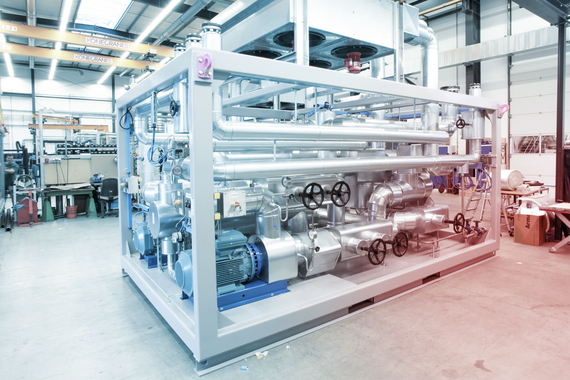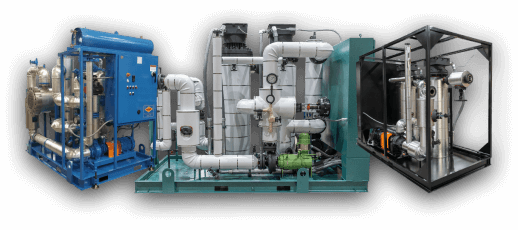Exploring the Potential of DVS Heat Transfer Systems in Modern Thermal Management
The Role of Heat Transfer Solutions in Sustainable Power Solutions for the Future
Heat transfer systems are crucial in the pursuit for lasting power options. They maximize thermal power management, enhancing the efficiency of eco-friendly modern technologies. By employing mechanisms like convection, radiation, and conduction, these systems lessen power losses. Their role in solar thermal and geothermal applications is especially considerable. As technologies emerge, the potential for further advancements raises vital concerns regarding future power strategies. What growths will form the landscape of sustainable power?
Comprehending Heat Transfer Equipments

The Value of Thermal Power Management
Effective thermal power administration is vital for taking full advantage of power efficiency and minimizing waste in various systems. By managing temperature level and enhancing Heat transfer processes, organizations can noticeably decrease power intake and operational costs. Reliable monitoring involves the execution of innovative innovations and practices that check and regulate thermal conditions within systems, ensuring that power sources are used successfully. In addition, proper thermal power monitoring adds to decreasing greenhouse gas emissions, aligning with international sustainability objectives. It also enhances system reliability and performance, leading to improved product quality and longer devices life-span. Eventually, prioritizing thermal energy management is an important step towards creating extra lasting power options and promoting a liable strategy to energy consumption in commercial and household contexts.
Applications of Heat Transfer in Renewable Resource
While numerous eco-friendly power sources assure sustainability, the effective application of Heat transfer plays an essential duty in their efficiency. In wind power systems, Heat transfer is made use of for generator element cooling, improving efficiency and long life. Geothermal power depends on effective Heat exchange between the planet's subsurface and the fluid distributing in the system, optimizing power removal. Biomass power procedures additionally benefit from Heat transfer, as it assists in transforming organic products into useful gas via pyrolysis and gasification. In addition, in hydropower, keeping excellent temperatures in reservoirs can boost energy outcome. Each of these applications demonstrates the important importance of Heat transfer systems in boosting renewable power technologies, ultimately contributing to a more lasting energy future.
Enhancing Solar Thermal Power Efficiency
As solar thermal power systems proceed to evolve, boosting their effectiveness has become vital for taking full advantage of power outcome. Advances in Heat transfer technologies, such as improved thermal storage space products and ingenious Heat exchangers, play a considerable function in improving performance. By using advanced materials that have superior thermal conductivity, systems can transfer and record Heat better. Furthermore, integrating monitoring systems that comply with the sunlight's path guarantees that collectors get perfect solar direct exposure throughout the day. Using nanotechnology in solar absorbers can better increase energy absorption prices. Furthermore, including computerized control systems assists manage and control temperatures power circulation effectively, causing reduced losses and enhanced general system efficiency. These enhancements lead the way for more sustainable solar thermal power solutions in the future.
Geothermal Heating: A Sustainable Remedy
Geothermal heating provides a viable option for lasting power, providing substantial environmental benefits via minimized greenhouse gas discharges. Its effectiveness and cost-effectiveness make it an appealing alternative to standard heater. Difficulties connected to execution has to be dealt with to optimize its potential effect.
Ecological Benefits of Geothermal
Traditional heating approaches contribute substantially to greenhouse gas exhausts, geothermal home heating offers an engaging choice that minimizes ecological influence. By harnessing the Planet's inner Heat, geothermal systems use a renewable resource source, substantially lowering reliance on nonrenewable fuel sources. This technique generates very little carbon discharges, making it a cleaner option for business and property home heating. Additionally, geothermal systems promote power effectiveness, as they need much less power contrasted to standard furnace. DVS Heat Transfer Systems. The application of geothermal power also helps in decreasing air contamination, boosting local air high quality and public health. As a lasting solution, geothermal home heating supports environment adjustment reduction initiatives, placing itself as an important element in the change in the direction of a greener future
Effectiveness and Cost-Effectiveness
How does geothermal heating gauge up in regards to performance and cost-effectiveness compared to traditional heating systems? Geothermal home heating demonstrates premium efficiency, usually accomplishing a coefficient of efficiency (POLICE OFFICER) of 3 to 5, suggesting it produces 3 to 5 devices of Heat for every single unit of electrical power consumed. This performance converts right into reduced operating prices, especially in regions with secure geothermal resources. First installation costs can be greater than conventional systems; nevertheless, long-lasting cost savings on energy expenses and lowered maintenance expenses can balance out these in advance investments. Furthermore, numerous federal governments incentivize geothermal systems through refunds and tax obligation credit reports, boosting their cost-effectiveness. Generally, geothermal home heating emerges as a economically sensible and sustainable choice to even more conventional home heating services.
Implementation Difficulties and Solutions
Various obstacles can restrain the prevalent application of geothermal heating unit, regardless of their clear advantages as a sustainable power service. High initial setup expenses typically discourage house owners and financiers, making funding a considerable barrier. In addition, the geographical restrictions of suitable geothermal websites restrict availability in particular areas. Local regulations and permitting procedures can additionally complicate project growth, resulting in delays. Public recognition and understanding of geothermal systems continue to be low, preventing approval. To address these difficulties, targeted education projects can boost open secret, while government rewards could alleviate monetary problems. Collaborating with local authorities to simplify regulations might help with smoother project approvals, eventually advertising the adoption of geothermal heating as a sensible, lasting power choice.
Developments in Heat Transfer Technologies
Technologies in Heat transfer modern technologies play a crucial duty in boosting energy performance and sustainability. Advanced Heat exchangers and stage modification materials go to the center of these growths, providing substantial renovations in thermal administration. These technologies not just optimize energy use however also add to reducing environmental effect in various applications.
Advanced Heat Exchangers
Advanced Heat exchangers play an important function in boosting power efficiency across numerous applications in sustainable energy remedies. These tools assist in the transfer of Heat between 2 or more liquids, considerably lowering power intake in procedures such as commercial heating, air conditioning, and power generation. Innovations in materials and style, such as the usage of nanofluids and small setups, have actually brought about boosted thermal efficiency and lowered size needs. In addition, advancements in digital surveillance and control systems permit optimized procedure, additional boosting efficiency. By reducing waste Heat and making best use of energy recuperation, advanced Heat exchangers contribute to reduce carbon impacts and support the shift toward environmentally friendly innovations. Their proceeded growth is crucial for accomplishing global energy sustainability goals.
Stage Adjustment Materials
The combination of stage modification products (PCMs) right into Heat transfer innovations represents a substantial innovation in energy administration and effectiveness. PCMs absorb and release thermal power throughout their phase changes, making it possible for reliable temperature level regulation in building materials and energy systems. By storing excess Heat throughout top durations and releasing DVS Heat Transfer Systems it when demand rises, PCMs contribute to pack moving and energy conservation - DVS Heat Transfer Systems. This capability enhances the performance of renewable resource systems, especially in solar thermal applications. Additionally, PCMs can enhance the thermal convenience of indoor environments, reducing dependence on traditional heating and cooling down methods. As advancements in PCM formulas continue to emerge, their role in sustainable power options is poised to grow, supplying encouraging opportunities for future research study and application

Future Leads for Heat Transfer in Lasting Energy
As the demand for lasting power solutions continues to rise, the duty of Heat transfer systems is ending up being significantly important in forming future technologies. Innovations in products and layouts are expected to improve effectiveness in Heat transfer, lowering energy losses in various applications. The integration of sophisticated thermal storage space systems, such as stage modification materials and thermochemical storage space, will certainly make it possible for much better management of energy sources. Research right into nanofluids and biomimetic Heat exchangers may even more enhance thermal performance. In addition, the fostering of wise innovations will certainly enable real-time monitoring and adaptive control of Heat transfer processes. These innovations are poised to considerably contribute to the general efficiency and sustainability of energy systems, paving the method for an extra energy-efficient future.
Frequently Asked Questions
Just How Can Individuals Execute Heat Transfer Equipment in the house?

Individuals can implement Heat transfer systems in the house by installing energy-efficient home appliances, utilizing radiant heat, and maximizing insulation. These actions improve power performance, minimize expenses, and advertise lasting methods in household atmospheres.

What Are the Prices Connected With Setting Up Heat Transfer Systems?
The prices connected with installing Heat transfer systems differ extensively, usually incorporating tools, installment labor, and maintenance. Aspects such as system kind, home dimension, and neighborhood regulations greatly influence the overall expense entailed.
Are There Federal Government Motivations for Heat Transfer System Installations?
Government rewards for Heat transfer system installments differ by region and can include tax obligation rebates, credit scores, and grants. These monetary benefits intend to encourage fostering, ultimately promoting power performance and minimizing ecological impact within areas.
How Do Heat Transfer Equipments Influence Energy Bills?
Heat transfer systems notably affect energy bills by maximizing power performance. By boosting the transfer of Heat, these systems minimize power intake, bring about reduced energy costs and producing an extra lasting technique to power administration.
What Upkeep Is Needed for Heat Transfer Equipments?
Upkeep for Heat transfer systems consists of normal assessments, cleansing of elements, inspecting fluid degrees, making sure proper insulation, and changing worn parts. These tasks aid maintain effectiveness, protect against breakdowns, and lengthen the system's functional life-span.
These systems facilitate the movement of thermal power from one tool to another, making it possible for the transfer of Heat for energy, air conditioning, or heating generation purposes. Geothermal energy depends on efficient Heat exchange between the planet's subsurface and the fluid flowing in the system, taking full advantage of energy removal. Furthermore, geothermal systems advertise energy effectiveness, as they require much less power contrasted to conventional heating systems. Advanced Heat exchangers play a vital role in improving power effectiveness throughout numerous applications in sustainable power services. Heat transfer systems notably influence power bills by optimizing energy efficiency.